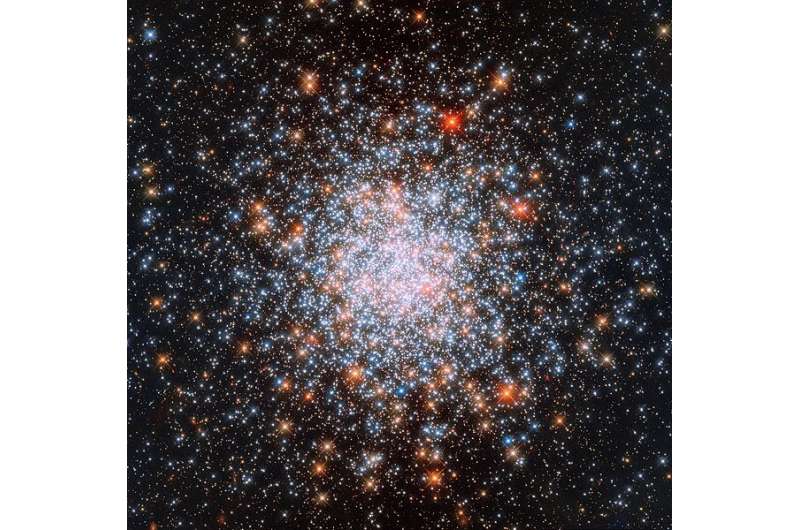September 11, 2019 report
Multiple stellar populations found in the cluster NGC 1866

Astronomers have performed a comprehensive study of stellar populations in the young globular cluster NGC 1866. The new study confirms that the cluster hosts multiple stellar populations, which could have implications for our understanding of young clusters in general. The research is detailed in a paper published September 4 on arXiv.org.
Observations show that almost all globular clusters (GCs) exhibit star-to-star abundance variations of light elements such as helium (He), oxygen (O), nitrogen (N), carbon (C) and calcium (Na). This indicates self-enrichment in GCs and suggests that star clusters are composed of at least two stellar populations.
That seems to be the case also with NGC 1866—one of the most populous young globular clusters in the Magellanic Clouds. Discovered in 1826, the cluster is located in the disk of the Large Magellanic Cloud. It is assumed that it hosts multiple stellar populations, including a large number of evolved stars and more than 20 Cepheid variables. For astronomers, NGC 1866 is one of the most interesting clusters for testing intermediate-age stellar populations and stellar evolutionary models.
A group of researchers led by Guglielmo Costa of International School for Advanced Studies (SISSA) in Trieste, Italy, has recently reinvestigated NGC 1866 with the aim of gathering more information regarding its stellar populations. The study was focused mainly on the analysis of evolutionary properties of five Cepheid variables in the cluster with extensively studied pulsational properties. They found that it is very unlikely that all the five Cepheids belong to the same stellar population.
"We performed a comprehensive study of the stellar populations in the young Large Magellanic Cloud cluster NGC 1866, combining the analysis of its best-studied Cepheids with that of a very accurate color-magnitude diagram (CMD) obtained from the most recent Hubble Space Telescope photometry. We used a Bayesian method based on new PARSEC stellar evolutionary tracks with overshooting and rotation to obtain ages and initial rotation velocities of five well-studied Cepheids of the cluster," the astronomers wrote in the paper.
The study found that one of the five studied Cepheids is significantly older than the remaining four. It is estimated that this star is about 288 million years old if it had high initial rotational velocity, or around 202 million years old if it is a slow rotator. The other four Cepheid variables belong to an initially slowly rotating young population with an estimated age of about 176 million years.
According to the authors of the paper, the results indicate that NGC 1866 hosts at least two distinct stellar populations. Moreover, the study suggests that the younger population is mainly made of slowly rotating stars, while the older population consists mainly of initially fast-rotating stars. The metallicity of both populations was found to be almost identical.
In concluding remarks, the researchers emphasized how their findings contribute to our understanding of young clusters and their stellar populations: "Our study not only reinforces the notion that some young clusters like NGC 1866 harbor multiple populations, but gives also hints that the first population, the older, may inherit the angular momentum from the parent cloud while stars of the second one, the younger, do not."
More information: Multiple stellar populations in NGC 1866. New clues from Cepheids and Colour-Magnitude Diagram, arXiv:1909.01907 [astro-ph.SR] arxiv.org/abs/1909.01907
© 2019 Science X Network




















